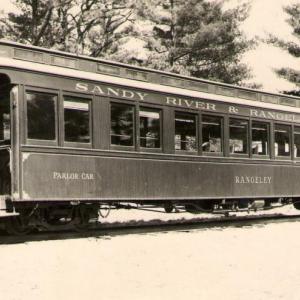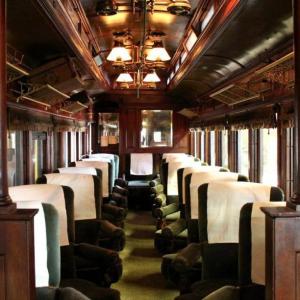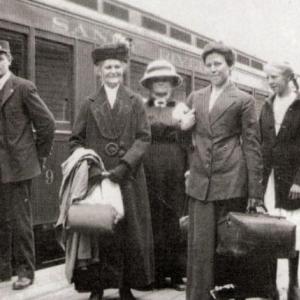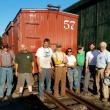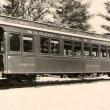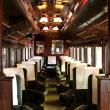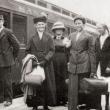Alna, Portland two-footer museums find new ways to steam ahead
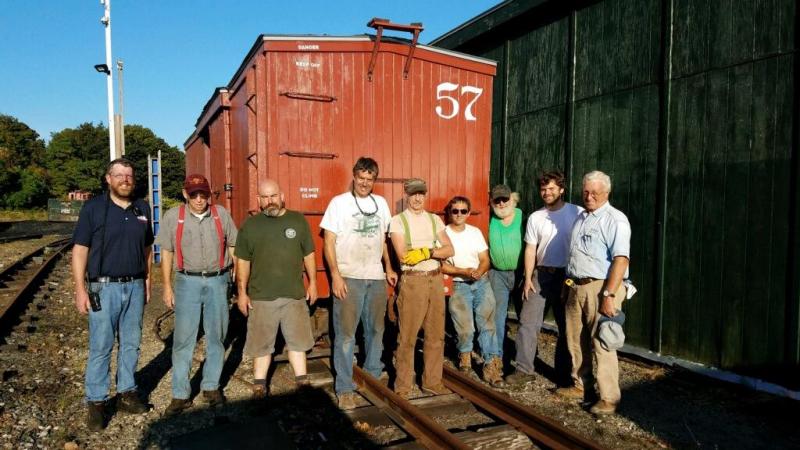 Volunteers from both the MNG and WW&F work together in the Portland yard to ready several box cars for the move to Alna last summer. Courtesy of Wesley Heinz
Volunteers from both the MNG and WW&F work together in the Portland yard to ready several box cars for the move to Alna last summer. Courtesy of Wesley Heinz
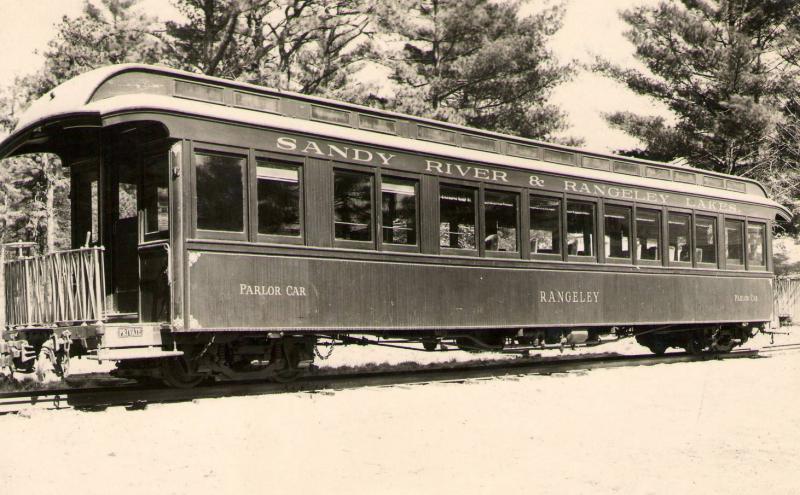 The world-class exhibition will be highlighted by the only historic two-foot gauge parlor car ever built in the United States, the Sandy River & Rangeley Lakes (SR&RL) “Rangeley.” Exterior, circa 1900. Photo from the Collection of the Maine Narrow Gauge Railroad Co. & Museum
The world-class exhibition will be highlighted by the only historic two-foot gauge parlor car ever built in the United States, the Sandy River & Rangeley Lakes (SR&RL) “Rangeley.” Exterior, circa 1900. Photo from the Collection of the Maine Narrow Gauge Railroad Co. & Museum
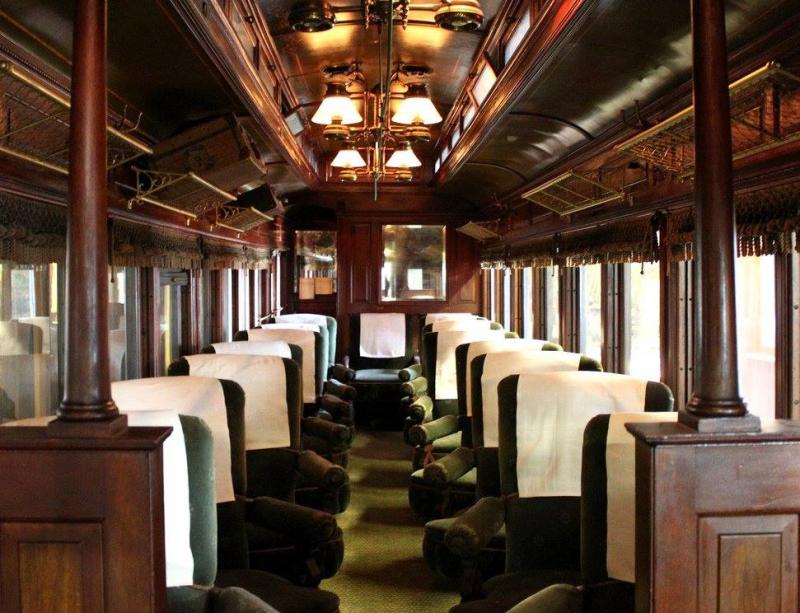 This car features plush swivel seats, a smoking section, a restroom, and other amenities. Courtesy of Maine Narrow Gauge Railroad Co. & Museum
This car features plush swivel seats, a smoking section, a restroom, and other amenities. Courtesy of Maine Narrow Gauge Railroad Co. & Museum
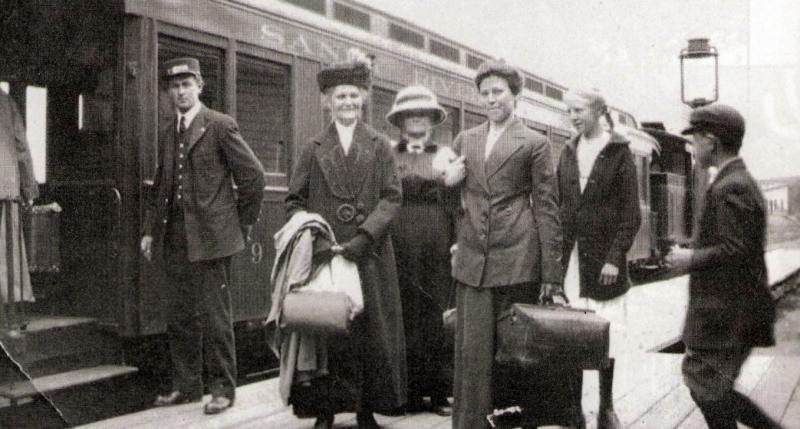 A rare photo of passengers boarding the Rangeley, probably around 1916. The women are Carrie Ellis, Betsy Tibets and Nora Pilsbury. From the Collection of the Maine Narrow Gauge Railroad Co. & Museum
A rare photo of passengers boarding the Rangeley, probably around 1916. The women are Carrie Ellis, Betsy Tibets and Nora Pilsbury. From the Collection of the Maine Narrow Gauge Railroad Co. & Museum
 A gathering of leaders from both organizations took place at Head Tide recently to plan for the public announcement of the exhibitions. From left, MNG board members Catherine Geren and Jerry Angier, Executive Director Wes Heinz, Board President John Marr, WW&F board members Jason Lamontagne, Brendan Barry, and Board President David Buczkowski. Courtesy of Gail Ciampa
A gathering of leaders from both organizations took place at Head Tide recently to plan for the public announcement of the exhibitions. From left, MNG board members Catherine Geren and Jerry Angier, Executive Director Wes Heinz, Board President John Marr, WW&F board members Jason Lamontagne, Brendan Barry, and Board President David Buczkowski. Courtesy of Gail Ciampa
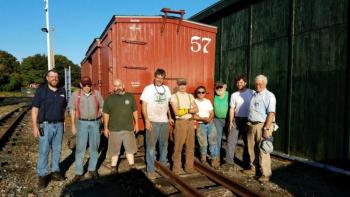 Volunteers from both the MNG and WW&F work together in the Portland yard to ready several box cars for the move to Alna last summer. Courtesy of Wesley Heinz
Volunteers from both the MNG and WW&F work together in the Portland yard to ready several box cars for the move to Alna last summer. Courtesy of Wesley Heinz
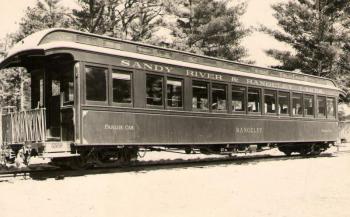 The world-class exhibition will be highlighted by the only historic two-foot gauge parlor car ever built in the United States, the Sandy River & Rangeley Lakes (SR&RL) “Rangeley.” Exterior, circa 1900. Photo from the Collection of the Maine Narrow Gauge Railroad Co. & Museum
The world-class exhibition will be highlighted by the only historic two-foot gauge parlor car ever built in the United States, the Sandy River & Rangeley Lakes (SR&RL) “Rangeley.” Exterior, circa 1900. Photo from the Collection of the Maine Narrow Gauge Railroad Co. & Museum
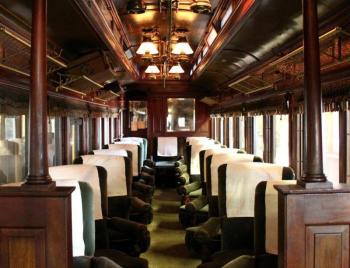 This car features plush swivel seats, a smoking section, a restroom, and other amenities. Courtesy of Maine Narrow Gauge Railroad Co. & Museum
This car features plush swivel seats, a smoking section, a restroom, and other amenities. Courtesy of Maine Narrow Gauge Railroad Co. & Museum
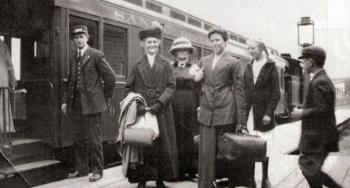 A rare photo of passengers boarding the Rangeley, probably around 1916. The women are Carrie Ellis, Betsy Tibets and Nora Pilsbury. From the Collection of the Maine Narrow Gauge Railroad Co. & Museum
A rare photo of passengers boarding the Rangeley, probably around 1916. The women are Carrie Ellis, Betsy Tibets and Nora Pilsbury. From the Collection of the Maine Narrow Gauge Railroad Co. & Museum
 A gathering of leaders from both organizations took place at Head Tide recently to plan for the public announcement of the exhibitions. From left, MNG board members Catherine Geren and Jerry Angier, Executive Director Wes Heinz, Board President John Marr, WW&F board members Jason Lamontagne, Brendan Barry, and Board President David Buczkowski. Courtesy of Gail Ciampa
A gathering of leaders from both organizations took place at Head Tide recently to plan for the public announcement of the exhibitions. From left, MNG board members Catherine Geren and Jerry Angier, Executive Director Wes Heinz, Board President John Marr, WW&F board members Jason Lamontagne, Brendan Barry, and Board President David Buczkowski. Courtesy of Gail Ciampa
Maine holds a special place in railroad history. Some call it Yankee ingenuity and others just plain frugality, but in the 1880s, five quirky little railroads started popping up around Maine. These mostly short-line and short-lived inventions ran on tracks that were just 24 inches between the rails. Most historic and modern trains in operation in the U.S. have 4 feet 8 1/2 inches between the rails.
The two-footers or narrow gauge were cheap and fast to build. They connected rural Maine towns and natural resources to the rest of the world in the days before the automobile. These railroads are the focus of two Maine museums that are coming together in the most modern of ways to preserve the past and inspire guests.
The Wiscasset, Waterville & Farmington Railway Museum (WW&F) in Alna and the Maine Narrow Gauge Railroad Co. & Museum (MNG) of Portland have a long history of partnering successfully, and the two organizations have just announced an unprecedented move to mount a major collaborative exhibition of two-footer history on the campus of the WW&F starting this spring.
The exhibition is highlighted by the only historic two-foot gauge parlor car ever built in the U.S., the Sandy River & Rangeley Lakes (SR&RL) “Rangeley.” The “Rangeley” operated only in summer when elite passengers paid a premium to ride in style from Farmington to the Rangeley Lakes House, a posh hotel with its own station. The car features plush swivel seats, a smoking section, a restroom and other amenities. It’s in almost pristine original condition and is a stunning piece of Maine history.
In addition, SR&RL combination car 14, Bridgton & Saco River (B&SR) coach 16 “Mt Pleasant,” and B&SR caboose 32 will arrive at Sheepscot Station later this year for public viewing and occasional operation on the WW&F railway. The WW&F’s car barn with three tracks will undergo renovations and additions to accommodate the exhibit and new interior displays to enhance visitor interaction when the cars aren’t in use.
WW&F Marketing Director Steve Piwowarski is especially excited about a reunion nearly 100 years in the making. Piwowarski explained, “Parlor car Rangeley and combine 14 are both from the Sandy River and Rangeley Lakes Railroad. Although Locomotive No. 9 has worked for the WW&F since 1933, it was built for the Sandy River Railroad in 1891. When the coaches arrive here, it will be the first time this equipment will be in the same place since 1924.”
Recent growth at the WW&F has been exponential including the completion of Trout Brook Bridge in only 11 months. The museum also announced in December that it had exceeded its campaign fundraising goals to put another two steam locomotives into operation. With more than 1,000 members around the world, dozens of dedicated volunteers from across Northern New England, and not one paid staff member, the WW&F’s award-winning accomplishments continue to stack up. Piwowarski said work is also continuing on a significant track extension to a new station adjacent to Midcoast Conservancy's Trout Brook Preserve in Head Tide. This project is referred to as the Mountain Extension and will be completed by 2021.
According to MNG Executive Director Wesley Heinz, “The exhibition is a natural evolution of the longtime tradition of traveling exhibitions and loans between museums all around the world. It also happens to provide a practical solution to providing continuing public access to an important historical collection of artifacts and operating equipment.” The exhibition’s timing is strategic. Heinz said the redevelopment of the Portland Company site, the home of MNG for more than 25 years, means that, within months, the museum must move collections as construction begins on the site for new commercial, residential and retail tenants.
MNG has an agreement with the State of Maine to operate on its right of way along Casco Bay in Portland well into the future. According to Heinz, “The year 2018 broke every record we have ever had including transporting more than 55,000 passengers. We’re invested in and staying in Portland. Trains will begin operating again on Feb. 2 as we embark on becoming a truly year-round presence along the shore of Casco Bay. The MNG will be open every weekend (operating all week during winter and spring school breaks), weather permitting, until we go back to seven-day a week service Saturday, April 13.” Heinz also shared plans for another 4,000 seats during the wildly popular and always sold-out, The Polar Express. He said MNG is not abandoning plans to move to Gray but is putting fundraising and permitting on hold for a while.
Both organizations are quick to give credit to a third person for their collaboration and upcoming exhibition. Brian Fanslau, owner of Maine Locomotive & Machine Works, is a supporter and service provider of both. When asked about his role, Fanslau said, “This is the kind of rare collaboration that is based on mutual trust and common goals where both partners are completely transparent about their objectives and where you just want to do whatever you can to make it successful. After all it’s really about making sure this history is preserved, it really doesn’t matter who owns what, if we are all committed to that.”
Fanslau’s business will provide storage for more pieces of the MNG collection, assist with transportation services, and play a part in maintenance and restoration of some equipment. Earlier this fall, WW&F and ML&MW installed a siding to provide a rail link between facilities and the WW&F main rail line. This will allow better access to both sites allowing for easier movement of rail equipment.
“MNG and the WW&F share a philosophy that the best way to preserve railroad equipment is to operate it,” says Jason Lamontagne, a WW&F board member. “The agreement we’ve reached with MNG is truly collaborative in a number of ways. First and foremost: It lets each organization continue to be itself. This is not a merger; each organization’s culture will continue to flourish in positive ways. Secondly: The agreement, while in writing, is flexible and cooperative. Without rigid boundaries, we’re free to jointly rise to unseen challenges and garner unexpected opportunities as they arise.”
All signs are for clear tracks ahead for these two museums leveraging each other’s strengths to rise above adversity and build upon their successes. They may be all about the trains, but they have taken to heart the adage that all boats rise on the tide.
To learn more about both museums and how this exciting new partnership continues to tell the big story of these small trains, visit www.mainenarrowgauge.org and wwfry.org
About Maine’s Historic Two-Foot Railroads
Sandy River and Rangeley Lakes (1879-1935) transported timber out of the Maine woods for construction and paper making along with passengers heading to Rangeley for hunting and fishing at Rusticator sporting camps and resorts.
Bridgton and Saco River (1881-1941) transported apples, coal, lumber and other manufactured goods between the lake communities and multitudes of passengers escaping Boston and Portland for Sebago Lake.
Monson (1883-1943) Often called the smallest railroad in the United States. Its purpose was to move slate from the Monson quarries to the Bangor & Aroostook Railroad Station six miles away.
Kennebec Central (1890-1929) Operated between the Kennebec River at Randolph and the veteran’s home at Togus. Moved passengers but most often, coal for heating the fast-growing facility.
Wiscasset, Waterville and Farmington (1894-1933, 1989-today) The line ran from Wiscasset in the south, to Albion and Winslow in the north, never making it to either Waterville or Farmington. Hauled potatoes, lumber, and poultry along with other general freight and passengers between these rural farming communities and the port at Wiscasset.
Event Date
Address
97 Cross Road
Alna, ME
United States


